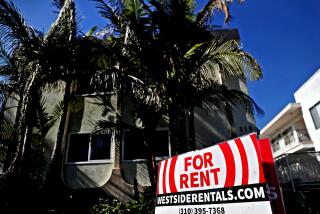Fannie, Freddie won’t budge: $417,000 is still the limit
- Share via
WASHINGTON — The conforming loan limit, perhaps the most intently watched number in the mortgage business, will remain unchanged next year at $417,000.
The limit is the legislatively set ceiling on the size of loans that can be purchased or guaranteed by Fannie Mae and Freddie Mac, the two government-sponsored financial institutions that keep local lenders awash in cash for home loans.
Because the enterprises bring a certain amount of standardization to the market, and because investors throughout the world believe the government-sponsored enterprises’ securities are backed by the full faith and credit of Uncle Sam, rates charged on loans at or below the limit are often 0.25% to 0.5% less expensive than so-called jumbo loans above the ceiling.
In addition, “sub-prime” borrowers whose credit doesn’t measure up to Fannie Mae and Freddie Mac’s strict underwriting standards also pay higher rates, no matter how much they are borrowing.
Normally, the Fannie-Freddie limit is determined by the percentage change in the average price of both new and existing housing from one October to the next as measured by the Federal Housing Finance Board.
The board said Monday that the average in October 2006 fell $501, from $306,759 a year earlier to $306,258. The slight 0.16% decline was the index’s first October-to-October dip since 1992-93.
The decline would have resulted in a $667 drop in the limit to $416,333. But James Lockhart, director of the Office of Federal Housing Enterprise Oversight, said he would not seek a lower limit next year “so as not to disrupt the end-of-year pipeline.”
The office, Fannie-Freddie’s safety and soundness regulator, took over responsibility for calculating the maximum in 2004 when it found that the two companies had adjusted the ceiling for that year somewhat higher than it should have been. Lockhart also said this year’s decline would be deferred until next November, when the conforming loan limit will be reset for 2008.
Because limits on government-insured loans are based on the conforming loan limit, it is likely the ceiling on Federal Housing Administration mortgages in high-cost areas such as Los Angeles will remain at $362,790 next year and $200,160 in most other markets.
The Department of Housing and Urban Development will make that determination before Jan. 1. It also is likely that HUD will adjust the FHA ceiling in some places, either up or down, depending on the most current average home prices.
Before this year’s decline in the finance board index, the average increase in the October-to-October price of houses over the previous five years was 8.8%. Last year’s limit was 15.9% above the $359,650 ceiling in 2005.
Although Housing Enterprise Oversight officials chose not to seek a lower ceiling, lenders in high-cost states continued to rail against the formula by which it is set, saying that it penalizes people living within their borders.
“Californians should have the same right to lower rates as everybody else,” said Michael Faust, a vice president of the California Assn. of Mortgage Brokers and chairman of the group’s government affairs committee.
The association and others are championing federal legislation that would place California and other high-cost markets on the short list of places such as Alaska and Hawaii where the ceiling is 150% higher than everywhere else.
The savings from such a change, said Faust, who is with American Pacific Mortgage in Roseville, Calif., could be as much as $750 billion nationwide. That kind of money, he said, “could affect people’s lives in many ways.”
The only other period in which the loan limit remained unchanged was a three-year stretch between 1993 and 1995, when it was $203,150. In 1990, the limit was lowered for the first and only time by $150, from $187,600 to $187,450.
Conforming limits for loans on other properties also will remain the same for 2007: $533,850 for mortgages on two-family properties; $645,300 for mortgages on three-family properties; and $801,950 for mortgages on four-family properties.
More to Read
Inside the business of entertainment
The Wide Shot brings you news, analysis and insights on everything from streaming wars to production — and what it all means for the future.
You may occasionally receive promotional content from the Los Angeles Times.










